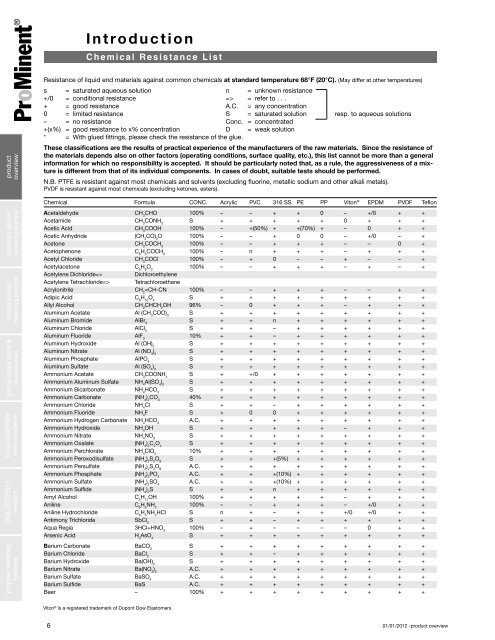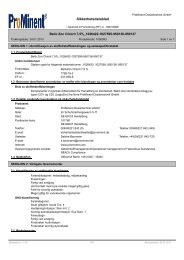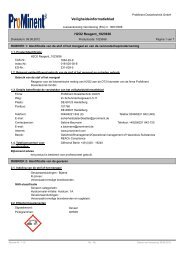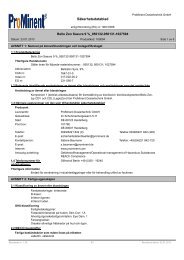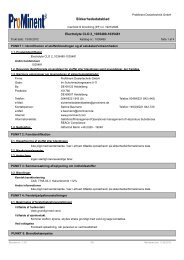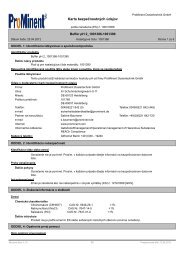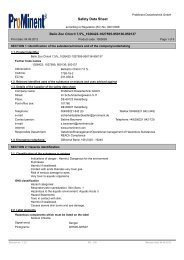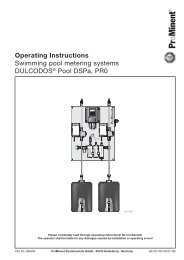Solenoid-Driven Metering Pumps - ProMinent Canada
Solenoid-Driven Metering Pumps - ProMinent Canada
Solenoid-Driven Metering Pumps - ProMinent Canada
Create successful ePaper yourself
Turn your PDF publications into a flip-book with our unique Google optimized e-Paper software.
product<br />
overview<br />
solenoid-driven<br />
metering pumps<br />
motor-driven<br />
metering pumps<br />
pump spare parts &<br />
accessories<br />
DULCOMETER ®<br />
instrumentation<br />
DULCOTEST ®<br />
sensors<br />
polymer blending<br />
systems<br />
Introduction<br />
Chemical Resistance List<br />
Resistance of liquid end materials against common chemicals at standard temperature 68°F (20°C). (May differ at other temperatures)<br />
s = saturated aqueous solution n = unknown resistance<br />
+/0 = conditional resistance => = refer to . . .<br />
+ = good resistance A.C. = any concentration<br />
0 = limited resistance S = saturated solution resp. to aqueous solutions<br />
– = no resistance Conc. = concentrated<br />
+(x%) = good resistance to x% concentration D = weak solution<br />
* = With glued fittings, please check the resistance of the glue.<br />
These classifications are the results of practical experience of the manufacturers of the raw materials. Since the resistance of<br />
the materials depends also on other factors (operating conditions, surface quality, etc.), this list cannot be more than a general<br />
information for which no responsibility is accepted. It should be particularly noted that, as a rule, the aggressiveness of a mixture<br />
is different from that of its individual components. In cases of doubt, suitable tests should be performed.<br />
N.B. PTFE is resistant against most chemicals and solvents (excluding fluorine, metallic sodium and other alkali metals).<br />
PVDF is resistant against most chemicals (excluding ketones, esters).<br />
Chemical Formula CONC. Acrylic PVC 316 SS PE PP Viton ® EPDM PVDF Teflon<br />
Acetaldehyde CH CHO 3 100% – – + + 0 – +/0 + +<br />
Acetamide CH CONH 3 2 S + + + + + 0 + + +<br />
Acetic Acid CH COOH 3 100% – +(50%) + +(70%) + – 0 + +<br />
Acetic Anhydride (CH CO) O 3 2 100% – – + 0 0 – +/0 – +<br />
Acetone CH COCH 3 3 100% – – + + + – – 0 +<br />
Acetophenone C H COCH 6 5 3 100% – n + + + – + + +<br />
Acetyl Chloride CH COCl 3 100% – + 0 – – + – – +<br />
Acetylacetone C H O 5 8 2 100% – – + + + – + – +<br />
Acetylene Dichloride=> Dichloroethylene<br />
Acetylene Tetrachloride=> Tetrachloroethane<br />
Acrylonitrile CH =CH-CN 2 100% – – + + + – – + +<br />
Adipic Acid C H O 6 10 4 S + + + + + + + + +<br />
Allyl Alcohol CH CHCH OH 2 2 96% – 0 + + + – + + +<br />
Aluminum Acetate Al (CH COO) 3 3 S + + + + + + + + +<br />
Aluminum Bromide AlBr3 S + + n + + + + + +<br />
Aluminum Chloride AlCl3 S + + – + + + + + +<br />
Aluminum Fluoride AlF3 10% + + – + + + + + +<br />
Aluminum Hydroxide Al (OH) 3 S + + + + + + + + +<br />
Aluminum Nitrate Al (NO ) 3 3 S + + + + + + + + +<br />
Aluminum Phosphate AlPO4 S + + + + + + + + +<br />
Aluminum Sulfate Al (SO ) 4 3 S + + + + + + + + +<br />
Ammonium Acetate CH COONH 3 4 S + +/0 + + + + + + +<br />
Ammonium Aluminum Sulfate NH Al(SO ) 4 4 2 S + + + + + + + + +<br />
Ammonium Bicarbonate NH HCO 4 3 S + + + + + + + + +<br />
Ammonium Carbonate (NH ) CO 4 2 3 40% + + + + + + + + +<br />
Ammonium Chloride NH Cl 4 S + + – + + + + + +<br />
Ammonium Fluoride NH F 4 S + 0 0 + + + + + +<br />
Ammonium Hydrogen Carbonate NH HCO 4 3 A.C. + + + + + + + + +<br />
Ammonium Hydroxide NH OH 4 S + + + + + – + + +<br />
Ammonium Nitrate NH NO 4 3 S + + + + + + + + +<br />
Ammonium Oxalate (NH ) C O 4 2 2 4 S + + + + + + + + +<br />
Ammonium Perchlorate NH ClO 4 4 10% + + + + + + + + +<br />
Ammonium Peroxodisulfate (NH ) S O 4 2 2 8 S + + +(5%) + + + + + +<br />
Ammonium Persulfate (NH ) S O 4 2 2 8 A.C. + + + + + + + + +<br />
Ammonium Phosphate (NH ) PO 4 3 4 A.C. + + +(10%) + + + + + +<br />
Ammonium Sulfate (NH ) SO 4 2 4 A.C. + + +(10%) + + + + + +<br />
Ammonium Sulfide (NH ) S 4 2 S + + n + + + + + +<br />
Amyl Alcohol C H OH 5 11 100% + + + + + – + + +<br />
Aniline C H NH 6 5 2 100% – – + + + – +/0 + +<br />
Aniline Hydrochloride C H NH HCl 6 5 2 S n + – + + +/0 +/0 + +<br />
Antimony Trichloride SbCl3 S + + – + + + + + +<br />
Aqua Regia 3HCl+HNO3 100% – + – – – – 0 + +<br />
Arsenic Acid H AsO 3 4 S + + + + + + + + +<br />
Barium Carbonate BaCO3 S + + + + + + + + +<br />
Barium Chloride BaCl2 S + + – + + + + + +<br />
Barium Hydroxide Ba(OH) 2 S + + + + + + + + +<br />
Barium Nitrate Ba(NO ) 3 2 A.C. + + + + + + + + +<br />
Barium Sulfate BaSO4 A.C. + + + + + + + + +<br />
Barium Sulfide BaS A.C. + + + + + + + + +<br />
Beer – 100% + + + + + + + + +<br />
Viton ® is a registered trademark of Dupont Dow Elastomers<br />
6 01/01/2012 -product overview


